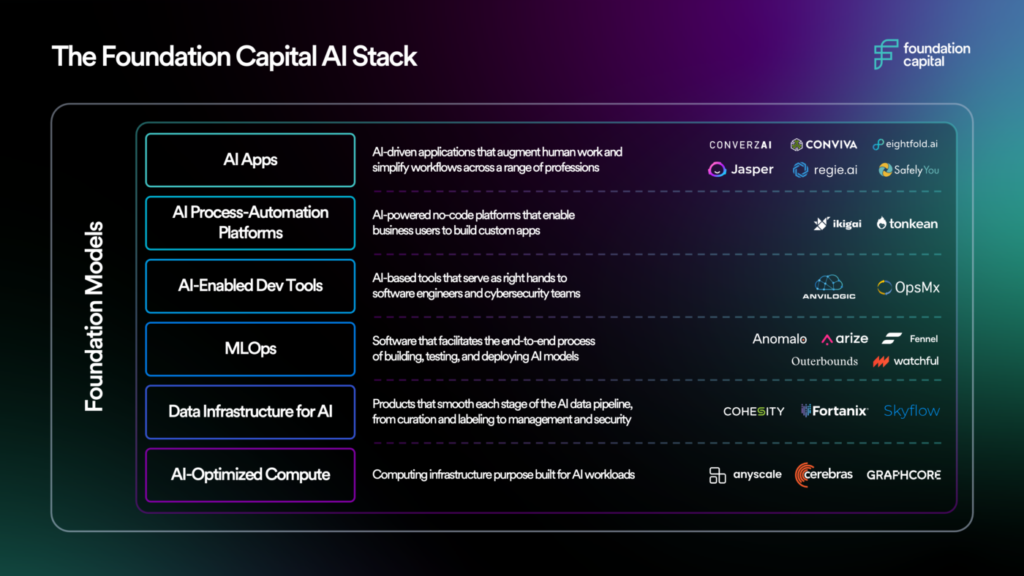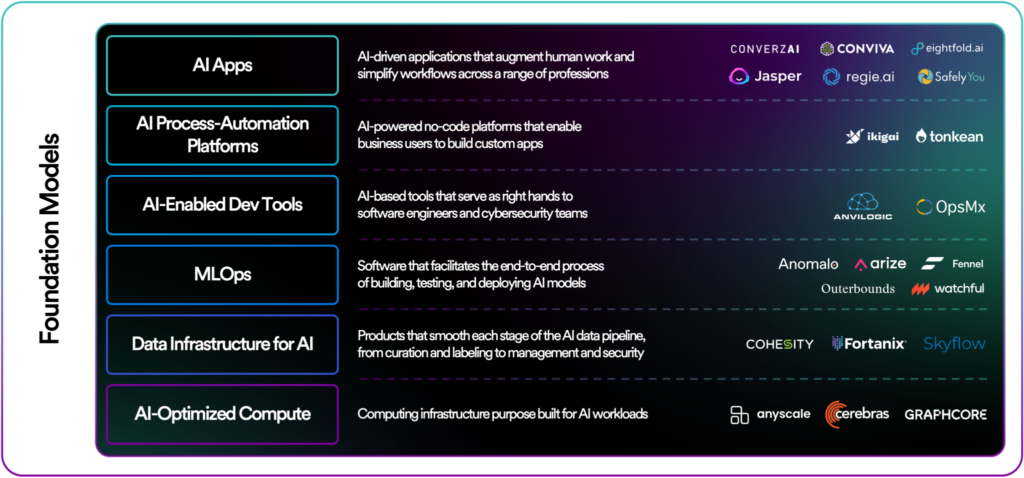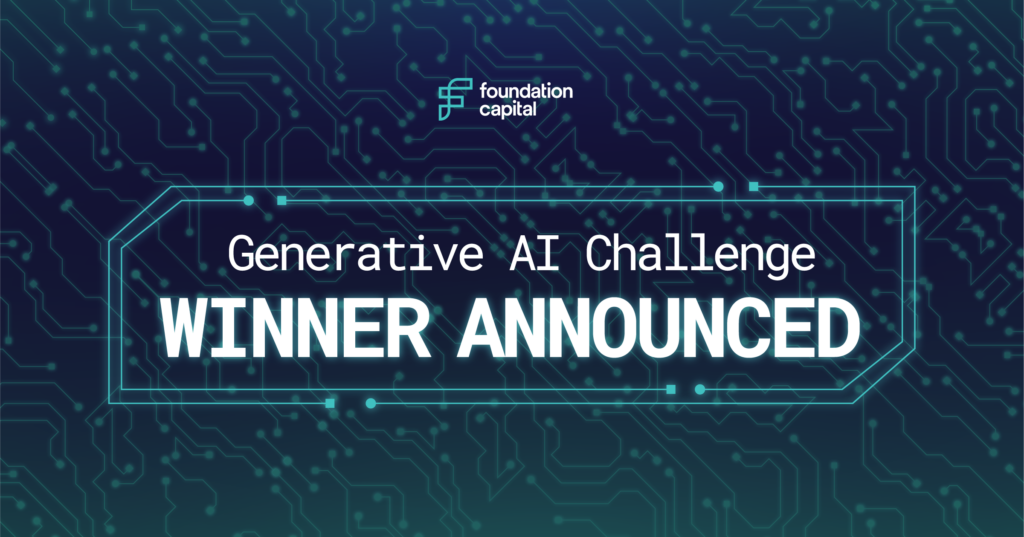A “New World” for Enterprise AI
In 2022, after decades of traveling along an exponential curve, AI has reached its own “new world” moment.
12.22.2022 | By Ashu Garg

Writing of Moore’s Law, futurist Stewart Brand presiciently described how exponential growth occasions stepwise change. “Later doublings in an exponential sequence, we come to realize, are absolutely ferocious. The changes no longer feel qualitative or quantitative but cataclysmic; each new doubling is a new world,” he explained.
In 2022, after decades of traveling along an exponential curve, AI has reached its own “new world” moment. Since 2018, the time to train an image classification system has sped up by 94.4%, while the cost of doing so has decreased roughly 10-fold each year: 50 times the pace of Moore’s Law. The cost of AI inference (putting a trained model in production) has fallen even more precipitously, with the price of classifying one billion images dropping from $10,000 to just $0.03 in the past two years. Research has intensified: the number of AI patents filed rose 30-fold from 2015 to 2021. Venture dollars have flooded into the space, with private investment in AI more than doubling between 2020 and 2021.
On November 30, 2022, the release of ChatGPT shed light on another core advance: the availability of foundation models as APIs. Trained on terabytes of internet data, these models, created by companies such as OpenAI, Google, Stability AI, and Cohere, can be adapted to a plethora of downstream use cases. Previous generations of AI entrepreneurs had to collect and prepare their own training data, design complex data processing techniques, select an appropriate model, and optimize that model for their desired use case. Today’s AI entrepreneurs can jumpstart new products by “fine-tuning” foundation models on data sets tailored to the task at hand. By decoupling model production from application development, highly performant foundation models like ChatGPT are poised to be AI’s “Netscape moment.”
At Foundation Capital, we believe that AI’s “new world” has just arrived. Sooner and more radically than we expect, AI will remake every major category of enterprise software. The size of the resulting economic opportunity is staggering: if properly implemented, AI has the potential to unlock between $10 and $15 trillion in value annually worldwide. (That’s 10–15% of global GDP.) In most cases, incumbents will be unable to effectively respond. The white space for startups to both disrupt existing industries and enter markets previously untouched by automation is immense.
The Foundation Capital Enterprise AI Stack
At Foundation, we’ve long had conviction in AI’s power to reinvent enterprise software. In 2012, we backed Aggregate Knowledge, an AI-based media-intelligence platform. We then turned to startups that were using AI to optimize marketing efforts, including TubeMogul and Amperity. Widespread inefficiencies in HR and recruiting motivated our investments in Eightfold and Turing. When inadequate infrastructure and tooling emerged as major blockers to AI development, we partnered with transformative companies like Databricks, Cerebras, Cohesity, Graphcore, Alation, and Anyscale.
Today, the Foundation Capital Enterprise AI Stack comprises six distinct layers. Together, they afford a holistic vision of how AI will rearchitect the enterprise, from the compute engine to end-user applications. Foundation models, positioned in the leftmost column, span the stack and have the ability to accelerate innovation at each layer. We’ll unpack the implications of foundation models for the enterprise in an upcoming post.
For now, let’s dive into each layer:
- AI Apps — These applications integrate AI to achieve tasks that were previously beyond the reach of automation. In each case, AI augments human labor and simplifies workflows across a wide range of professions, from marketing and customer success to healthcare and HR. Eightfold, an AI-powered talent intelligence platform that helps businesses hire, retain, and upskill workers, is one such example. As foundation models rapidly improve, AI applications will need to double down on defensibility. Simply sitting as a thin software layer atop a pretrained model will no longer be enough. Moats may lie in proprietary data sets, specialized algorithms, intuitive user interfaces, internal data flywheels (for example, by crafting workflows that prompt users to provide feedback, thus further feeding the algorithm), and integrating one-off features into end-to-end products.
- AI process-automation platforms — While task-specific AI apps apply out-of-the-box to common enterprise use cases, this layer of stack allows businesses to build customized, AI-based applications without eating into engineering bandwidth. These drag-and-drop platforms like Tonkean and Ikigai enable legal, sales, finance, HR, and customer support teams to synthesize and capture value from disparate internal data sources—no coding required. By routing these data streams through AI systems, business users can automate complex processes, streamline cross-functional workflows, create high-fidelity forecasts, and much more.
- AI-enabled engineering tools — AI-powered tools promise to revolutionize how engineers write, deploy, and debug software and secure computer systems. In the case of software development, startups like OpsMx are using AI to perform low-creativity tasks such as testing and documentation, lower communication barriers between teams, and automate deployment, resulting in faster time to market and countless engineering hours saved. Other AI-driven startups like Anvilogic serve as valuable right hands to cybersecurity teams by automating system monitoring, simulating attacks, and generating test vectors to detect nascent threats, among other urgent tasks.
- MLOps — Today, only 54% of AI models enter production. By bringing the best practices of DevOps to machine learning, a new batch of startups, like Arize and Fennel, are addressing the root causes behind this statistic. Each provides a suite of AI-based tools that help ML engineers rapidly and reliably build, test, and deploy AI models. Their automated logging, tracing, and alerting solutions audit models’ performance and behavior in real time, enabling teams to quickly identify and resolve issues. Further opportunities exist for AI-grounded collaboration and communication software that connects the multiple stakeholders involved in ML projects, from data scientists to business analysts, and ensures progress toward shared goals.
- Data infrastructure for AI — As AI development adopts a data-centric paradigm, curating, preparing, managing, and securing the vast amounts of data required to train and improve models is becoming increasingly mission-critical. The stakes are only rising as businesses turn to proprietary data (which is often sensitive in nature) to enhance AI performance. Startups can address the numerous pain points along the data pipeline, including integrating real-time data into AI models; programmatically extracting, cleaning, and labeling training data from both structured and unstructured sources; and generating synthetic training data. In addition, solutions like Fortanix and Skyflow that allow businesses to safely store and access their data across public and private clouds, encrypt sensitive information, and comply with changing data-privacy laws will become ever-more essential in coming years.
- AI-optimized compute — AI workloads differ dramatically from traditional cloud applications built around web servers and databases. They thus require special configurations of hardware and software to reach optimal performance. One way to improve the efficiency of training and deploying AI models is to develop better hardware, such as GPUs and TPUs. With the notable exception of a handful of startups, such as Cerebras and Graphcore, this has traditionally been the remit of large companies due to its capital intensity. A second way—and where the opportunity for most new entrants lies—is to optimize compute, along with the models themselves. For example, Anyscale enables the use of distributed computing for model training. Clouds that are purpose built for AI workloads, with specialized silicon, schedulers, and interconnect, represent another growing market where startups can play.
Conclusion
At Foundation, we believe that 2023 will be a critical time to build for AI startups. If you’re an entrepreneur focused on the enterprise AI stack, we’d love to hear from you! Reach out with details on your product and team to jgupta@foundationcap.com or agarg@foundationcap.com.
Published on 12.22.2022
Written by Ashu Garg

